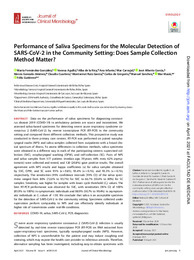Título :
Performance of Saliva Specimens for the Molecular Detection of SARS-CoV-2 in the Community Setting: Does Sample Collection Method Matter? |
Autor :
Fernández-González, Marta 
Agulló, Vanesa 
de la Rica-Martinez, Alba 
Infante, Ana 
Carvajal, Mar
GARCIA GOMEZ, JOSE ALBERTO 
Gonzalo Jiménez, Nieves 
Cuartero, Claudio
Ruiz García, Montserrat
de Gregorio, Carlos
Sánchez-Molla, Manuel 
Masiá, Mar
Gutiérrez, Félix  |
Editor :
American Society for Microbiology |
Departamento:
Departamentos de la UMH::Medicina Clínica |
Fecha de publicación:
2021 |
URI :
https://hdl.handle.net/11000/37901 |
Resumen :
Data on the performance of saliva specimens for diagnosing coronavirus
disease 2019 (COVID-19) in ambulatory patients are scarce and inconsistent. We
assessed saliva-based specimens for detecting severe acute respiratory syndrome coronavirus
2 (SARS-CoV-2) by reverse transcriptase PCR (RT-PCR) in the community
setting and compared three different collection methods. This prospective study was
conducted in three primary care centers. RT-PCR was performed on paired nasopharyngeal
swabs (NPS) and saliva samples collected from outpatients with a broad clinical
spectrum of illness. To assess differences in collection methods, saliva specimens
were obtained in a different way in each of the participating centers: supervised collection
(SVC), oropharyngeal washing (OPW), and self-collection (SC). Pairs of NPS
and saliva samples from 577 patients (median age, 39 years; 44% men; 42% asymptomatic)
were collected and tested, and 120 (20.8%) gave positive results. The overall
agreement with NPS results and kappa coefficients (κ) for saliva samples obtained
by SVC, OPW, and SC were 95% (κ = 0.85), 93.4% (κ = 0.76), and 93.3% (κ = 0.76),
respectively. The sensitivities (95% confidence intervals [95% CI]) of the saliva specimens
ranged from 86% (72.6% to 93.7%) for SVC to 66.7% (50.4% to 80%) for SC
samples. Sensitivity was higher for samples with lower cycle threshold (CT) values. The
best RT-PCR performance was observed for SVC, with sensitivities (95% CI) of 100%
(85.9% to 100%) in symptomatic individuals and 88.9% (50.7% to 99.4%) in asymptomatic
individuals at CT values of #30. We conclude that saliva is an acceptable specimen
for the detection of SARS-CoV-2 in the community setting. Specimens collected under
supervision perform comparably to NPS and can effectively identify individuals at
higher risk of transmission under real-life conditions.
|
Palabras clave/Materias:
COVID-19
saliva
SARS-CoV-2
PCR
diagnostics |
Área de conocimiento :
CDU: Ciencias aplicadas: Medicina |
Tipo de documento :
info:eu-repo/semantics/article |
Derechos de acceso:
info:eu-repo/semantics/openAccess
Attribution-NonCommercial-NoDerivatives 4.0 Internacional |
DOI :
https://doi.org/10.1128/jcm.03033-20 |
Publicado en:
Journal of Clinical Microbiology, 59(4), 10.1128/jcm.03033-20 - March 2021 |
Aparece en las colecciones:
Artículos Medicina Clínica
|

 La licencia se describe como: Atribución-NonComercial-NoDerivada 4.0 Internacional.
La licencia se describe como: Atribución-NonComercial-NoDerivada 4.0 Internacional.
.png)